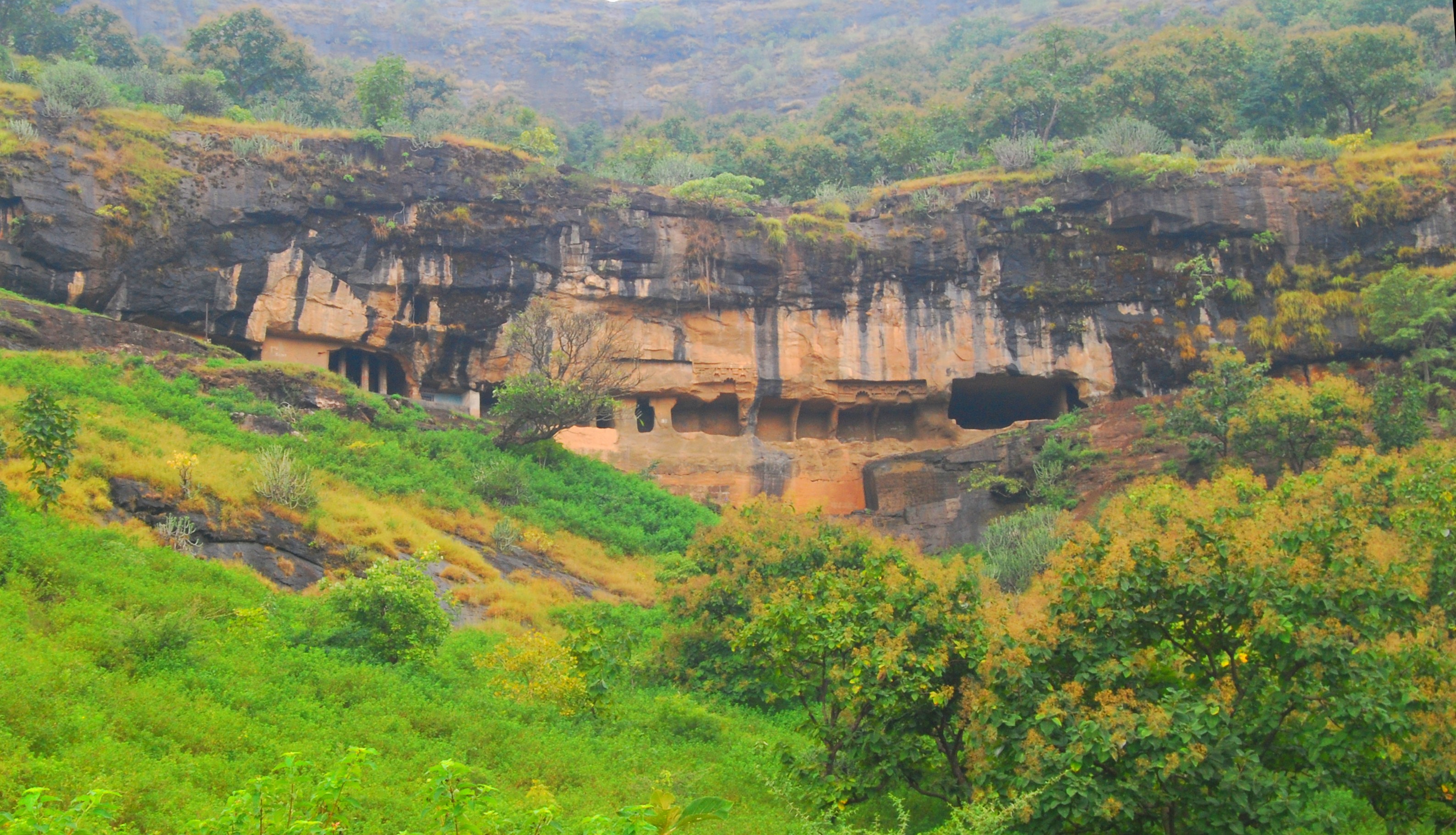Tulja Caves on:
[Wikipedia]
[Google]
[Amazon]
Tulja Caves (Tulja Lena) are located beyond the Shivneri hill, about 4km to the west of
 The dagoba is perfectly plain, but its capital has been hewn off to convert it into a huge
The dagoba is perfectly plain, but its capital has been hewn off to convert it into a huge  Next to these are two more plain fronts, and then two with Chaitya-window heads over where the doors have been, and smaller ones between, and the "rail ornament" and quadrantal carved roll supported by slender brackets in entire relief, as at the
Next to these are two more plain fronts, and then two with Chaitya-window heads over where the doors have been, and smaller ones between, and the "rail ornament" and quadrantal carved roll supported by slender brackets in entire relief, as at the 



Kevin Standage, An Indian Travel Photography Blog (Tulja Lena caves)
Buddhist caves in India Caves of Maharashtra Indian rock-cut architecture Former populated places in India Buddhist pilgrimage sites in India Buddhist monasteries in India Buddhist temples in India Stupas in India Architecture in India Caves containing pictograms in India {{Buddhism-stub
Junnar
Junnar (Marathi pronunciation: ͡ʒunːəɾ is a city in the Pune district of the Indian state of Maharashtra. The city has history dating back to the first millennium. The nearby fort of Shivneri was the birthplace of Maratha king Chatrap ...
, India
India, officially the Republic of India (Hindi: ), is a country in South Asia. It is the List of countries and dependencies by area, seventh-largest country by area, the List of countries and dependencies by population, second-most populous ...
. Other caves surrounding the city of Junnar are: Manmodi Caves
The Manmodi Caves are a complex of a rock-cut caves about 3 km to the south of the city of Junnar in India. Other caves surrounding the city of Junnar are: Tulja Caves, Shivneri Caves and Lenyadri caves.
It is thought that the caves were ...
, Shivneri Caves and Lenyadri caves
Lenyadri, sometimes called Ganesa Lena, Ganesh Pahar Caves, are a series of about 30 rock-cut Buddhist caves, located about north of Junnar in Pune district in the Indian state of Maharashtra. Other caves surrounding the city of Junnar are: ...
.
The cave has circular Chaitya
A chaitya, chaitya hall, chaitya-griha, (Sanskrit:''Caitya''; Pāli: ''Cetiya'') refers to a shrine, sanctuary, temple or prayer hall in Indian religions. The term is most common in Buddhism, where it refers to a space with a stupa and a rounded ...
hall surrounded by twelve octagonal pillars around Stupa
A stupa ( sa, स्तूप, lit=heap, ) is a mound-like or hemispherical structure containing relics (such as ''śarīra'' – typically the remains of Buddhist monks or nuns) that is used as a place of meditation.
In Buddhism, circum ...
. These caves are one of the earliest caves of Junnar
Junnar (Marathi pronunciation: ͡ʒunːəɾ is a city in the Pune district of the Indian state of Maharashtra. The city has history dating back to the first millennium. The nearby fort of Shivneri was the birthplace of Maratha king Chatrap ...
, excavated around 50 B.C. This Buddhist
Buddhism ( , ), also known as Buddha Dharma and Dharmavinaya (), is an Indian religion or philosophical tradition based on teachings attributed to the Buddha. It originated in northern India as a -movement in the 5th century BCE, and ...
cave
A cave or cavern is a natural void in the ground, specifically a space large enough for a human to enter. Caves often form by the weathering of rock and often extend deep underground. The word ''cave'' can refer to smaller openings such as sea ...
group consist of 11 cave. Cave No 4 is used as a temple of goddess Tulja Devi.
Description
The Tulja Lena caves lie in a hill about a mile and a half or two miles north-west fromJunnar
Junnar (Marathi pronunciation: ͡ʒunːəɾ is a city in the Pune district of the Indian state of Maharashtra. The city has history dating back to the first millennium. The nearby fort of Shivneri was the birthplace of Maratha king Chatrap ...
, beyond the north end of Sivaneri hill. They owe their name to a shrine of Tulja Devi, a form of Bhavani
Bhavānī (also known as Bhāvya, Tulajā, Turajā, Tvarita, Aṃbā, Jagadambā and Aṃbē) is manifestation of Adi Shakti (Durga). Bhavani translates to "giver of life", meaning the power of nature or the source of creative energy. She is co ...
, the consort of Shiva
Shiva (; sa, शिव, lit=The Auspicious One, Śiva ), also known as Mahadeva (; Help:IPA/Sanskrit, ɐɦaːd̪eːʋɐ, or Hara, is one of the Hindu deities, principal deities of Hinduism. He is the Supreme Being in Shaivism, one o ...
(see Tulja Bhavani Temple
Tulja Bhavani Temple (Marathi: श्री क्षेत्र तुळजा भवानी देवस्थान) is a Hindu temple dedicated to goddess Bhavani (goddess Parvati), also referred to as Durga and Sati. It is located in ...
).
The caves run along the face of the cliff nearly from south-east to north-west, facing about south-west, but all the façades have fallen away. They consist of a number of cells and two small viharas, with a Chaitya
A chaitya, chaitya hall, chaitya-griha, (Sanskrit:''Caitya''; Pāli: ''Cetiya'') refers to a shrine, sanctuary, temple or prayer hall in Indian religions. The term is most common in Buddhism, where it refers to a space with a stupa and a rounded ...
cave of a form quite unique. It is circular in plan, 25 feet 6 inches across, with a dagoba in the centre, 8 feet 2 inches in diameter, surrounded by twelve plain octagonal shafts 11 feet in height, supporting a dome over the dagoba. The surrounding aisle is roofed by a half arch rising from the wall to the upper side of an architrave 7 or 8 inches deep over the pillars.
 The dagoba is perfectly plain, but its capital has been hewn off to convert it into a huge
The dagoba is perfectly plain, but its capital has been hewn off to convert it into a huge linga
A lingam ( sa, लिङ्ग , lit. "sign, symbol or mark"), sometimes referred to as linga or Shiva linga, is an abstract or aniconic representation of the Hindu god Shiva in Shaivism. It is typically the primary ''murti'' or devotional ...
of Shiva
Shiva (; sa, शिव, lit=The Auspicious One, Śiva ), also known as Mahadeva (; Help:IPA/Sanskrit, ɐɦaːd̪eːʋɐ, or Hara, is one of the Hindu deities, principal deities of Hinduism. He is the Supreme Being in Shaivism, one o ...
, and even the dome is much hacked into, while some of the pillars have been notched and others broken.
In front of this cave and the one on each side of it is a platform built by the modern devotees of Tulja Devi.
Over the front of one of the cells to the north-east of this are left some Chaitya-window ornamentation, a larger one over where the door has been, the inner arch of which is filled with knotted ribbons etc..., similar to what is over the Chaitya-cave door at the Nasik Caves
The Nasik Caves, or Trirashmi Leni (''Trirashmi'' being the name of the hills in which the caves are located, ''Leni'' being a Marathi word for caves), are a group of 23 caves carved between the 1st century BCE and the 3rd century CE, though ...
, while the front of the arch is carved with flowers. On each side of this is a smaller arch; and farther to the left is a dagoba in half relief with the umbrella or chhatri
''Chhatri'' are elevated, dome-shaped pavilions used as an element in Indo-Islamic architecture and Indian architecture. Originating as a canopy above tombs, they serve as decorative elements. The earliest example of chhatri being used in the ...
over it, on each side a Gandharva
A gandharva () is a member of a class of celestial beings in Dharmic religions, such as Hinduism, Buddhism, and Jainism, whose males are divine performers such as musicians and singers, and the females are divine dancers. In Hinduism, they are ...
or Kinnara above, and a male figure below, that to
the right attended by a female, but all of them weatherworn. Over all is a projecting frieze carved on front with the "Buddhist rail pattern".
 Next to these are two more plain fronts, and then two with Chaitya-window heads over where the doors have been, and smaller ones between, and the "rail ornament" and quadrantal carved roll supported by slender brackets in entire relief, as at the
Next to these are two more plain fronts, and then two with Chaitya-window heads over where the doors have been, and smaller ones between, and the "rail ornament" and quadrantal carved roll supported by slender brackets in entire relief, as at the Bhaja Caves
Bhaja Caves is a group of 22 rock-cut caves dating back to the 2nd century BC located in the city of Pune, India. The caves are 400 feet above the village of Bhaja, on an important ancient trade route running from the Arabian Sea eastward into th ...
.



References
External links
Kevin Standage, An Indian Travel Photography Blog (Tulja Lena caves)
Buddhist caves in India Caves of Maharashtra Indian rock-cut architecture Former populated places in India Buddhist pilgrimage sites in India Buddhist monasteries in India Buddhist temples in India Stupas in India Architecture in India Caves containing pictograms in India {{Buddhism-stub